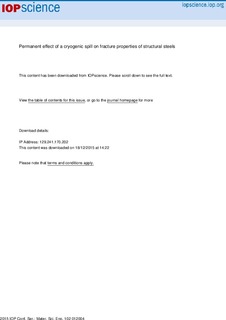| dc.contributor.author | Keseler, Hanne | |
| dc.contributor.author | Westermann, Ida | |
| dc.contributor.author | Kandukuri, Sastry Yagnanna | |
| dc.contributor.author | Nøkleby, John Olav | |
| dc.contributor.author | Holmedal, Bjørn | |
| dc.date.accessioned | 2017-10-02T13:05:01Z | |
| dc.date.available | 2017-10-02T13:05:01Z | |
| dc.date.created | 2015-12-18T15:37:28Z | |
| dc.date.issued | 2015 | |
| dc.identifier.citation | IOP Conference Series: Materials Science and Engineering. 2015, 102 . | nb_NO |
| dc.identifier.issn | 1757-8981 | |
| dc.identifier.uri | http://hdl.handle.net/11250/2457756 | |
| dc.description.abstract | Fracture analysis of a standard construction steel platform deck, which had been exposed to a liquid nitrogen spill, showed that the brittle fracture started at a flaw in the weld as a consequence of low-temperature embrittlement and thermal stresses experienced by the material. In the present study, the permanent effect of a cryogenic spill on the fracture properties of carbon steels has been investigated. Charpy V-notch impact testing was carried out at 0 °C using specimens, from the platform deck material. The average impact energy appeared to be below requirements only for transverse specimens. No pre-existing damage was found when examining the fracture surfaces and cross sections in the scanning electron microscope. Specimens of the platform deck material and a DOMEX S355 MCD carbon steel were tensile tested immersed in liquid nitrogen. Both steels showed a considerable increase in yield- and fracture strength and a large increase in the Lüders strain compared to the room temperature behavior. A cryogenic spill was simulated by applying a constant tensile force to the specimens for 10 min, at -196 C. Subsequent tensile tests at room temperature showed no significant influence on the stress-strain curve of the specimens. A small amount of microcracks were found after holding a DOMEX S355 MCD specimen at a constant force below the yield point. In a platform deck material tensile tested to fracture in liquid nitrogen, cracks associated with elongated MnS inclusions were found through the whole test region. These cracks probably formed as a result of the inclusions having a higher thermal contraction rate than the steel, causing decohesion at the inclusion-matrix interface on cooling. Simultaneous deformation may have caused formation of cracks. Both the microcracks and sulphide related damage may give permanently reduced impact energy after a cryogenic exposure. | nb_NO |
| dc.language.iso | eng | nb_NO |
| dc.publisher | IOP Publishing | nb_NO |
| dc.rights | Navngivelse 4.0 Internasjonal | * |
| dc.rights.uri | http://creativecommons.org/licenses/by/4.0/deed.no | * |
| dc.title | Permanent effect of a cryogenic spill on fracture properties of structural steels | nb_NO |
| dc.type | Journal article | nb_NO |
| dc.type | Peer reviewed | nb_NO |
| dc.description.version | publishedVersion | nb_NO |
| dc.source.pagenumber | 8 | nb_NO |
| dc.source.volume | 102 | nb_NO |
| dc.source.journal | IOP Conference Series: Materials Science and Engineering | nb_NO |
| dc.identifier.doi | 10.1088/1757-899X/102/1/012004 | |
| dc.identifier.cristin | 1302786 | |
| dc.description.localcode | Content from this work may be used under the terms of the Creative Commons Attribution 3.0 licence. Any further distribution of this work must maintain attribution to the author(s) and the title of the work, journal citation and DOI. | nb_NO |
| cristin.unitcode | 194,66,35,0 | |
| cristin.unitname | Institutt for materialteknologi | |
| cristin.ispublished | true | |
| cristin.fulltext | original | |
| cristin.qualitycode | 1 | |

